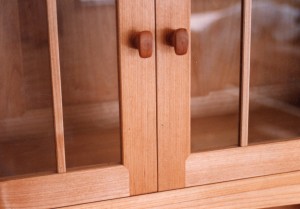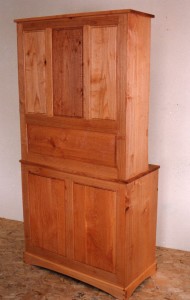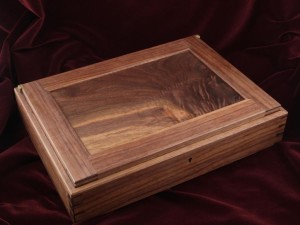 While identifying a quality product is sometimes easy, knowing just what makes the difference can be harder to spot. Just what is quality? Most people have an idea about what quality is to them and when it comes to furniture I have very entrenched ideas as to what this is to me.
While identifying a quality product is sometimes easy, knowing just what makes the difference can be harder to spot. Just what is quality? Most people have an idea about what quality is to them and when it comes to furniture I have very entrenched ideas as to what this is to me.
A long time ago I heard the phrase, fitness for purpose. I don’t know who said it but this ranks really high on my list. Because I don’t care how much effort you put into it, or how nice the materials are that you used, if the piece doesn’t serve it’s intended purpose there really wasn’t a reason to make it in the first place. You might find it surprising that I feel that this is the most important element to quality. If a piece doesn’t fit its intended use, it is not going to make the grade in my eyes.
Appearance alone is no sure fire way to pick out quality. Something pretty may catch your eye but closer inspection will tell you whether or not its worth having. In your mind paint it grey and ask yourself whether or not it is still a good design. Trust your own opinion. Thinking of it grey eliminates the influence of the wood and finish, lets you judge it on shape and proportion.
Just how well doors and drawers fit are right up there with fitness for purpose. A finely fit wood on wood drawer is a wonderful thing. Metal slides cannot compare to the feel of a drawer that was carefully made and properly fit. And just what is a finely fit drawer? Pull it out and push it closed with one finger on the corner of the drawer, if it easily closes that is a well fit drawer. If it is loose or poorly fit, it will bind up in a hurry.
 As for a door, is the gap around it even? And small as well, about the thickness of a business card? Maybe two cards between double doors. Doors should close quietly. A frame and panel door should never rattle. The hinges should fit tightly in their mortises with next to no gaps. What latches the door? It should be smooth and not interfere with the door closing. My latches are made not purchased. No click of metal hooks or a magnet. Just a bit of tension from the spring in the latch keeps things closed. A small block at the bottom of the door keeps the door from getting pushed down by the latch.
As for a door, is the gap around it even? And small as well, about the thickness of a business card? Maybe two cards between double doors. Doors should close quietly. A frame and panel door should never rattle. The hinges should fit tightly in their mortises with next to no gaps. What latches the door? It should be smooth and not interfere with the door closing. My latches are made not purchased. No click of metal hooks or a magnet. Just a bit of tension from the spring in the latch keeps things closed. A small block at the bottom of the door keeps the door from getting pushed down by the latch.
Knobs or Pulls play an important role as well. Are they comfortable to the hand and fingers? Do they fit in or do they look like an add on? How about placement? They should be sized to the drawer and large drawers may even need two.
The inside of a cabinet doesn’t have to be as nice as the outside but it should be done up neatly. No excess glue in the corners, no mill marks or torn up grain. Smooth and unfinished works for me. You could always wax the interior to keep it from getting dirty. I usually use a scented wax on the interior if I can.
 What about the back of a piece. In my mind it should be finished to the point that the piece can be placed away from the wall. For years we had one of my china cabinets placed as a room divider. All of my furniture is made this way, so it does not matter where it is placed. And finishing the back goes along with why I like making furniture, it stands alone. If the back is unfinished it has to rely on a wall to finish it off, it no longer stands alone.
What about the back of a piece. In my mind it should be finished to the point that the piece can be placed away from the wall. For years we had one of my china cabinets placed as a room divider. All of my furniture is made this way, so it does not matter where it is placed. And finishing the back goes along with why I like making furniture, it stands alone. If the back is unfinished it has to rely on a wall to finish it off, it no longer stands alone.
Is the joinery used on a cabinet appropriate? You don’t always have to use some fancy joint to hold things together. Sometimes the simplest solution is the best solution. Dovetails and fancy mortise and tenons by themselves don’t mean quality, it’s the skill in which they were cut that is more important.
Construction methods are important but some good ones don’t show at all. While othere types of joinery can conceal all sorts of sloppiness. Only by learning about joinery will you be able to pick up on the differences.
Surfaces should be finished appropriately. And that may be with no finish at all. I have seen some really nice burnished surfaces or some unique surface textures that would be ruined by an applied finish.
Finish is important but it doesn’t have to be so shiny it looks like plastic. To me the finish should be thin enough to allow the wood to be felt. Some finishes used properly appear like no finish at all. About the only place I like to see glossy, almost glass like surfaces is on exterior woodwork on boats. And this actually has a practical purpose, glossy finishes don’t hold and collect dirt. Which is important for a boat but not so much on the furniture in your house.
 In the end quality is a package deal. And just like hand tools it is not something you only apply to the surface. It has to start at the foundation and follow (or lead) the maker through every step of the way. Quality is buried in the details but comes out when all those details are put together.
In the end quality is a package deal. And just like hand tools it is not something you only apply to the surface. It has to start at the foundation and follow (or lead) the maker through every step of the way. Quality is buried in the details but comes out when all those details are put together.
